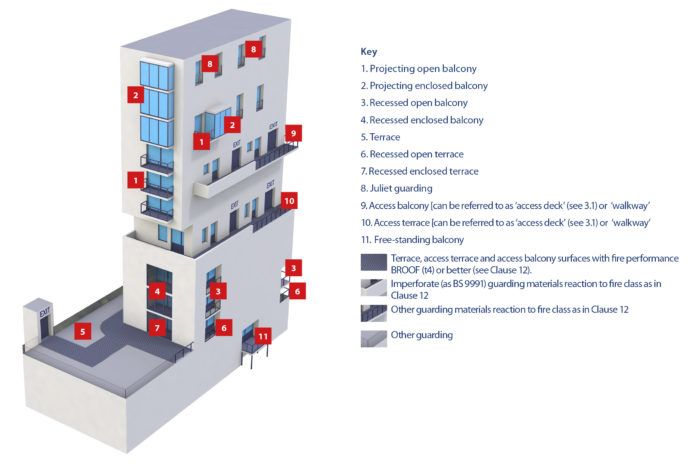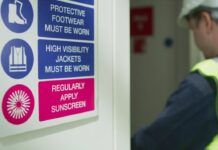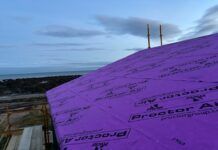Sarah Spink, chief executive officer of the Liquid Roofing and Waterproofing Association, explains how the new British Standard 8579:2020 affects how balconies and terraces are designed, and the impact on the waterproofing industry.
Following the Grenfell Tower tragedy, new regulations and guidance is forcing the construction industry to change, including all those involved in waterproofing.
The publication of Dame Judith Hackitt’s report in 2018 marked the first major step towards raising standards, outlining recommendations relating to all areas of construction, with the report including an entire chapter dedicated to products.
Changes so far…
In response to the recommendations, the government’s first action was to ban the use of combustible materials on high-rise residential buildings. This amendment to building regulations came into force in England on 21 December, 2018.
It prohibits the use of combustible materials anywhere in the external walls of high-rise residential buildings over 18m above ground level and containing one or more dwelling, in England.
Almost a year later in September 2019, building regulations covering fire safety – Approved Document B – was amended and updated. This stated that any products with membranes forming part of external walls on high-rise residential buildings need to meet the BS EN 13501-1 fire class requirements and achieve a result that deems them non-combustible.
The new rules apply to anything deemed as a ‘specified attachment’, which is defined as a balcony attached to an external wall, so only non-combustible materials can be used for these structures.
There were a lot of unanswered questions as to the definition of the different types of balconies and roofs, and what falls under the ban. The launch of BS 8579 has offered guidance on the design of balconies and terraces, as well as their component parts, and the document was released as approved British Standard guidance in August 2020.
Definition of a balcony
In section 3.2 of the Standard is clear guidance on what a balcony is: “an accessible external amenity platform above ground level exterior to and with direct access from a building.” It also states that a balcony formed above an external space that is not a habitable room, is not regarded or designed as storage space and for the purposes of fire, a balcony is not a roof.
Definition of a terrace
Within BS 8579, it states a terrace is an “…external accessible surface above an internal space above ground level exterior to and with direct access from a building to occupants for purposes other than exclusively maintenance.”
And clarifies that a terrace is a roof for the purposes of fire and waterproofing, and can also perform the function of a floor. Certain spaces might incorporate features of both a balcony and terrace.
Materials and components in respect to fire
Within the Standard, there is guidance on what materials and components can and cannot be used in respect to fire safety and regulation.
With regards to components of balconies on all buildings with an occupied floor over 11m above the lowest ground level – including the supporting structure in a free-standing balcony – only materials achieving class A1 or A2 – s1, d0, in accordance with BS EN 13501-1:2018 should be used. Components for balconies for all other buildings and arrangements should be risk assessed of fire spread, and reduced where possible within the design.
Where not possible to achieve all aspects of fire safety and performance using materials of at least class A1 or A2-s1, d0, minor components such as seals, gaskets, fixings, laminated glass, thermal breaks and membranes – which includes waterproofing membranes – could be exempt from this recommendation if an assessment of the risks proves adequate resistance to the spread of fire.
With regards to roof terraces, they should be designed to ensure the spread of fire is mitigated on the terrace itself, or where a terrace is adjacent to another structure or a compartment within the building.
To achieve this, the guidance advises the following:
1.As an occupied roof, a terrace performs the function of a floor. If this is over 11m above the lowest ground level build-up within 3m of an extensive vertical facade above, it may be limited to classification BROOF(t4) in accordance with BS EN 13501-5:2016.
2. A terrace containing planting may be divided by narrower strips of material achieving minimum classification BROOF(t4) in accordance with BS EN 13501-5:2016 in different orientations.
3. A terrace containing planting may also be divided by walls of fire-resisting construction in different orientations.
Staying informed
This year, the LRWA has worked closely with fellow trade associations to clarify how the regulations should be interpreted, and these new updates are issued directly to our members.
However, if you are in any doubt about the use of liquid waterproofing on new high-rise residential buildings and compliance with the regulations, please email our technical team at technical@lrwa.org.uk.




